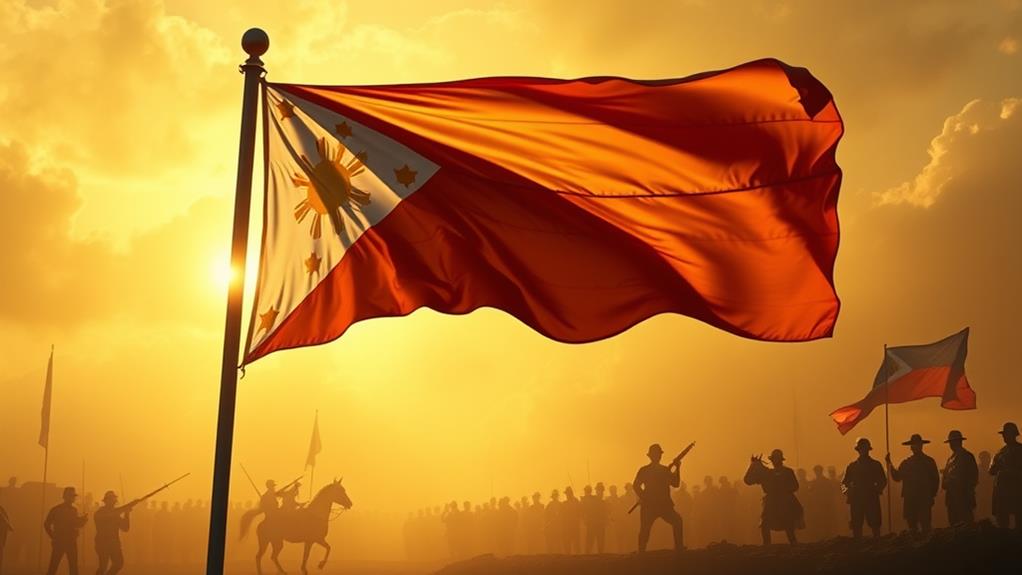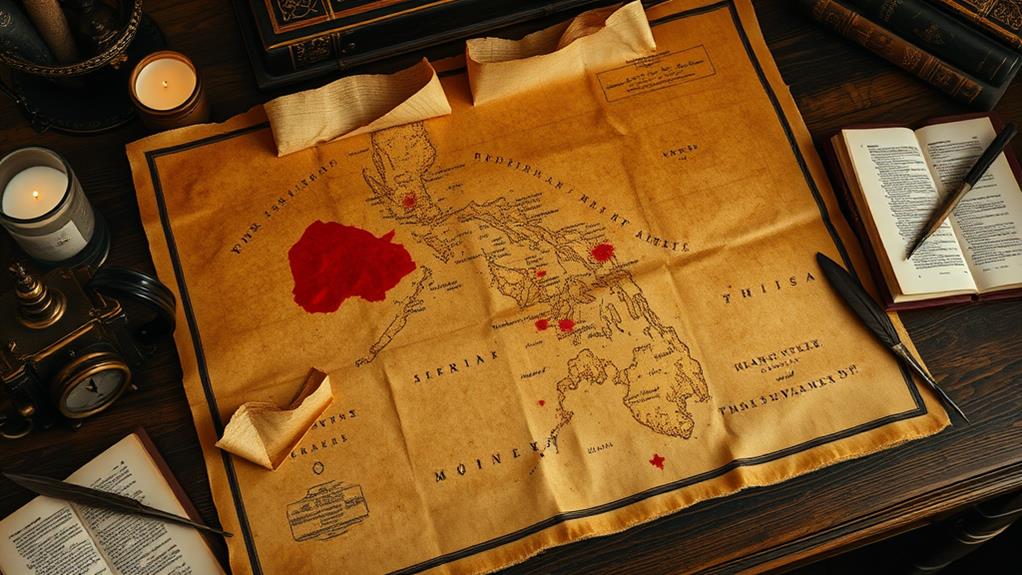The Philippine Revolution was a pivotal moment in Philippine history that shaped the nation's identity and paved the way for its independence.
It began in 1896, sparked by nationalist sentiments. Key figures like Emilio Aguinaldo led the revolution, and on June 12, 1898, Aguinaldo declared Philippine independence.
However, the Treaty of Paris, signed in 1898, sparked tensions that led to the Philippine-American War, which lasted until 1902.
Throughout the revolution, Aguinaldo's leadership was marked by internal conflicts, which hindered the country's progress towards true independence.
The long and arduous road to self-governance was filled with challenges, but ultimately, it revealed the nation's struggle for independence.
Early Life and Revolutionary Roots
Early Life and Leadership
Emilio Aguinaldo's early years laid the foundation for his future role in the Philippine Revolution. Born on March 22 or 23, 1869, near Cavite, Philippines, he grew up in a family of political significance, with his father serving as mayor of Cavite Viejo.
Aguinaldo attended San Juan de Letrán College in Manila but left before graduating to help his widowed mother manage the family farm. This early exposure to responsibility and leadership prepared him for future endeavors.
Path to the Philippine Revolution
In August 1896, Aguinaldo became mayor of Cavite Viejo, a position that set the stage for his involvement in the Philippine Revolution.
He joined the revolutionary society Katipunan, which fought against Spanish colonial rule. This marked the beginning of his journey towards becoming a key figure in the fight for independence.
He would eventually become the first president of the provisional republic and proclaim Philippine independence on June 12, 1898.
The Fight for Independence Begins
The Philippine Revolution began on August 23, 1896, when the secret society Katipunan was discovered. This marked the start of a long and difficult fight for independence from Spanish rule.
Key Events:
| Event | Date |
|---|---|
| Discovery of Katipunan | August 23, 1896 |
| First major conflict in Manila | Late 1896 |
| Declaration of Philippine independence | June 12, 1898 |
The revolution spread throughout the archipelago, leading to significant victories for Filipino revolutionaries. Emilio Aguinaldo emerged as a key leader, playing a crucial role in various battles against Spanish forces. However, the revolution faced challenges from internal conflicts, such as the execution of Andres Bonifacio, which created divisions within the revolutionary movement.
Aguinaldo's Leadership and Wars

Emilio Aguinaldo's Rise to Leadership
Emilio Aguinaldo's emergence as a key leader marked a significant shift in the Philippine Revolution. In 1895, he joined the Katipunan, a revolutionary society, and quickly rose through the ranks.
On June 12, 1898, he proclaimed Philippine independence, a bold move that would change the course of the revolution.
The Pact of Biac-na-Batō and Exile
In 1897, Aguinaldo signed the Pact of Biac-na-Batō, which allowed him to go into exile.
However, he returned in 1898 to continue the fight against Spanish colonial rule. This decision showed his commitment to the revolution and his desire to free the Philippines from Spanish control.
The First Philippine Republic
On January 23, 1899, Aguinaldo declared the establishment of the First Philippine Republic, marking the Philippines as a republic with the ratification of the Malolos Constitution.
This was a significant milestone in the country's history, as it established the Philippines as a sovereign nation.
The Philippine-American War
However, the Philippine-American War erupted on February 4, 1899, due to tensions between Aguinaldo's government and U.S. forces following the Treaty of Paris, which ceded the Philippines to the U.S.
Aguinaldo led the resistance, fighting against the American forces, but was eventually captured on March 23, 1901.
He took an oath of allegiance to the United States, effectively ending active resistance against American rule.
Post-War Political Life and Later Years
Post-War Political Life and Later Years
After surrendering to the United States, Emilio Aguinaldo retired from active leadership and received a pension from the U.S. government in 1901. However, this didn't mark the end of his political life. Aguinaldo remained involved in Philippine politics, running for president under the Commonwealth government in 1935, although he lost decisively.
During World War II, Japanese forces used Aguinaldo as a propaganda tool, and he made a radio appeal to U.S. General Douglas MacArthur in early 1942.
After the war, Aguinaldo was appointed to the Council of State in 1950, where he advocated for veterans' rights and promoted nationalism.
In his later years, Aguinaldo focused on private life, shifting away from active politics.
Nevertheless, he continued to shape the country's path towards independence by promoting nationalism and advocating for veterans' rights.
Legacy and Historical Significance

The Philippine Revolution: A Legacy of Independence
The Philippine Revolution, led by Emilio Aguinaldo, was a pivotal event that paved the way for the country's first attempt at self-governance and freedom from colonial rule.
This revolution laid the groundwork for the establishment of the First Philippine Republic, marking a significant milestone in the country's struggle for independence.
The revolution's legacy is deeply rooted in the country's nationalism, which emerged as a distinct identity separate from Spanish colonial influences.
The revolution's impact on the country's future can't be overstated, as it led to the continued celebration of June 12 as Philippine Independence Day, commemorating the declaration of independence from Spain in 1898.
The revolution's struggle for independence ultimately led to the country's full sovereignty on July 4, 1946, leaving a lasting legacy that continues to shape the nation's identity and politics today.
Historical Recognition and Commemoration
The Philippines Honors Its Fight for Independence
The Philippines commemorates its courageous fight for independence from colonial powers through monuments and memorials across the nation. Emilio Aguinaldo, a key figure in the revolution, is recognized as a national hero, with his contributions to Filipino nationalism highlighted in historical narratives.
Important Dates in Philippine History
| Date | Event | Significance |
|---|---|---|
| June 12, 1898 | Aguinaldo declared Philippines' independence | Marks the beginning of the revolutionary government |
| July 4, 1946 | Initially recognized as Philippine Independence Day | Celebrated independence from American colonial rule |
| 1962 | President Macapagal moved Independence Day to June 12 | Honors the original proclamation of independence |
| Ongoing | Debates about Aguinaldo's collaboration during World War II | Influences discussions about his legacy and historical interpretation |
June 12, 1898: A Significant Date in Philippine History
The significance of June 12, 1898, as Philippine Independence Day is celebrated annually, marking the proclamation of independence. This historical recognition is a testament to the nation's fight for independence, ensuring that the revolution's importance is not forgotten.
The Road to Independence

The Philippine Revolution Ignites
In 1896, the spark of revolution ignited in the Philippines, fueled by nationalist sentiments and the desire for independence from Spanish rule. This marked the beginning of a crucial period in Philippine history, where the fight for freedom and self-governance reached its peak.
The Proclamation of Independence
June 12, 1898, marked a significant step towards self-rule when Emilio Aguinaldo proclaimed the country's independence. This bold move was a culmination of the Philippine Revolution, which had been gaining momentum since 1896.
The Treaty of Paris
The Treaty of Paris, signed on December 10, 1898, ceded the Philippines to the United States. This agreement sparked tensions that would eventually lead to the Philippine-American War.
The treaty marked a significant turning point in the country's history, as it transferred control from Spain to the United States.
The Philippine-American War
The conflict between Filipino forces and American troops officially began on February 4, 1899, lasting until 1902. This war was a direct result of the tensions sparked by the Treaty of Paris.
The conflict was a brutal and devastating period in Philippine history.
The End of Active Resistance
Aguinaldo's capture on March 23, 1901, and his subsequent oath of allegiance to the United States effectively ended the active resistance of the Philippine Revolution.
This marked the beginning of the end of the revolution, paving the way for the eventual establishment of a colonial government.
How Did Spanish Colonization Lead to the Philippine Revolution for Freedom and Independence?
The impact of spanish colonization on the Philippines was significant, leading to country-wide resistance and eventually, the Philippine Revolution. The exploitation of resources, forced labor, and cultural oppression fueled the desire for freedom and independence. The atrocities committed by the Spanish colonial rulers united Filipinos in their quest for liberation.
Independence and Its Challenges
June 12, 1898: A Bittersweet Independence Day
As the Philippines declared independence on June 12, 1898, a mix of emotions filled the air: pride, hope, and uncertainty. The journey to this moment was long and arduous, but the road ahead seemed uncertain.
The Treaty of Paris: A Betrayal
The Treaty of Paris, signed on December 10, 1898, ceded the Philippines to the United States for $20 million, sparking feelings of betrayal among Filipino soldiers. This move tested their allegiance to the United States, leaving them wondering if they could trust their new rulers.
The Philippine-American War: A Brutal Conflict
The Philippine-American War broke out on February 4, 1899, and it was brutal. Over 40,000 Filipino lives were lost, and 4,000 American casualties were reported.
Aguinaldo became the leader of the resistance, but he was captured on March 23, 1901, marking the end of organized resistance.
Guerrilla warfare continued, and the war officially ended on July 4, 1902.
A Distant Dream of True Independence
Despite the official end of the war, true independence was still a distant dream. The complexities of U.S. colonial rule continued to spark debates about national sovereignty, leaving Filipinos wondering if they'd really gained independence at all.
The road to true independence was long and challenging, filled with uncertainty and struggle.
Questions and Answers
What Is Philippine Revolution for Independence?
The Philippine Revolution for Independence was a significant event where Filipinos fought for freedom from foreign rule.
This revolution, driven by nationalist sentiments, aimed to create a self-governing state, free from external dominance. The primary goal was to end centuries of colonial control and establish their nation's sovereignty.
Filipinos sought to gain autonomy, self-determination, and the right to shape their own destiny.
This courageous struggle led to the country's independence from foreign powers.
How Did the Philippines Fight for Independence?
The Philippines fought for independence through a series of strategic movements and wars.
The country's struggle for independence began with the formation of a secret society called the Katipunan, led by Andrés Bonifacio, to gain independence from Spanish colonial rule. This society played a crucial role in igniting the flame of resistance against Spanish rule.
The Philippines declared its independence on June 12, 1898, marking a significant milestone in the country's history. This led to the establishment of the First Philippine Republic under the leadership of Emilio Aguinaldo.
However, the United States refused to recognize the new republic, which further fueled the fight for independence.
The Philippine-American War ensued, with the Filipinos intensifying their fight against American forces. Although Emilio Aguinaldo was captured in 1901, the Filipinos continued to engage in guerrilla warfare for years, demonstrating their unwavering determination for freedom.
What Was the Goal of the Revolution in the Philippines?
The primary goal of the revolution in the Philippines was to attain independence from Spanish colonial rule.
This goal was driven by the desire for self-determination, where Filipinos sought to establish a sovereign government that represented their interests and rights.
The revolution aimed to break free from colonial subjugation, which had persisted for over three centuries.
This struggle was rooted in a desire for social reforms and national unity.
What Is the Revolution Filipina All About?
The Revolution Filipina is a struggle for freedom and self-governance.
It was a fight against foreign rule to create a sovereign nation.
This revolution was about Filipinos rising up against colonial powers to assert their identity, culture, and right to independence.
Nationalism, reform, and the quest for autonomy are key themes that emerge when exploring the Revolution's history and significance.